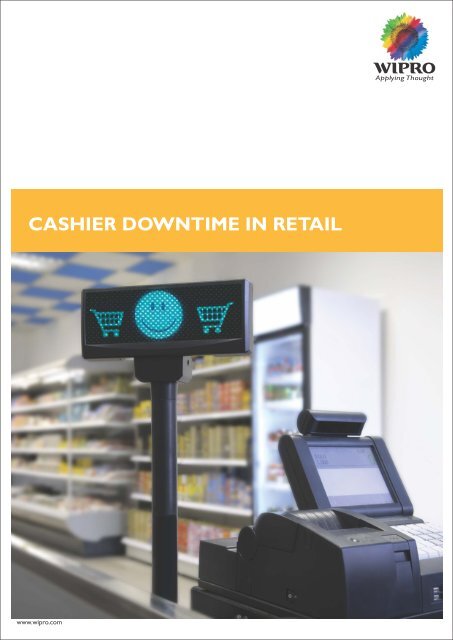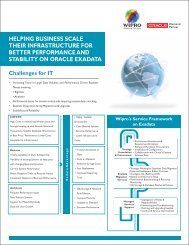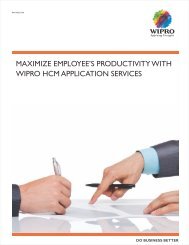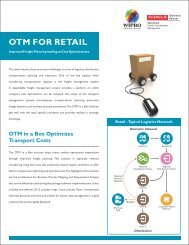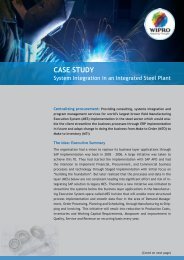Cashier downtime in retail vsf 07 12 11 final web
Cashier downtime in retail vsf 07 12 11 final web
Cashier downtime in retail vsf 07 12 11 final web
You also want an ePaper? Increase the reach of your titles
YUMPU automatically turns print PDFs into web optimized ePapers that Google loves.
CASHIER DOWNTIME IN RETAIL<br />
www.wipro.com
CONTENTS<br />
Background <strong>Cashier</strong> Downtime<br />
<strong>Cashier</strong> Downtime Analysis<br />
Queu<strong>in</strong>g Theory<br />
Queu<strong>in</strong>g Scenarios<br />
Solution to Reduce <strong>Cashier</strong> Downtime<br />
Metrics to Capture <strong>Cashier</strong> Downtime & Productivity<br />
Examples to Illustrate <strong>Cashier</strong> Downtime & Productivity Metrics<br />
Conclusion<br />
About the Author<br />
Mass merchandisers, discount <strong>retail</strong>ers, grocery <strong>retail</strong>ers and department stores have a unique challenge at the po<strong>in</strong>t of sale related to their cashier workforce.<br />
While these varied <strong>retail</strong> formats sell many products, the value and volume per sale is lower and the typical customer return frequently to the store. To meet<br />
the expected service level standards and reduce customer wait times, these environments have to keep multiple lanes open at all times. This leads to not only<br />
higher cost for the front lanes but also <strong>in</strong>creased <strong>downtime</strong> per lane. Without accurate measurements, the operational expenses related to the cashiers<br />
cannot be reduced. This article gives an overview of cashier <strong>downtime</strong> and metrics to calculate and control it on a real time basis.<br />
By Amit Dhall, Wipro Technologies<br />
3<br />
3<br />
4<br />
5<br />
5<br />
7<br />
7<br />
7<br />
8
Background <strong>Cashier</strong> Downtime<br />
In a <strong>retail</strong> environment, with the enormous push to improve customer shopp<strong>in</strong>g experience, there is a need to keep<br />
as many checkout lanes open as can be and thus br<strong>in</strong>g the customer wait time to the m<strong>in</strong>imum or <strong>in</strong> other words<br />
reach the idle state of one customer <strong>in</strong> a lane with no wait time. But to reach this stage, the store has to put an<br />
enormous cost on the payroll.<br />
Due to <strong>in</strong>tense competition and customer service becom<strong>in</strong>g a very critical<br />
parameter, store managers generally ignore the cost <strong>in</strong>volved <strong>in</strong> keep<strong>in</strong>g<br />
excessive lanes open and hence the payroll cost gets skewed towards the<br />
cashiers. This is further compounded by a tendency of the management to<br />
ignore operational expenses of the front lanes <strong>in</strong> the name of<br />
customer service.<br />
This can lead to the neglect of other parts of the store particularly with a<br />
limited store budget.<br />
A scenario where<strong>in</strong> the focus is to reduce checkout time by keep<strong>in</strong>g the<br />
cost skewed towards the front lanes can lead to the store managers<br />
keep<strong>in</strong>g the workforce on the front lanes and thus overlook<strong>in</strong>g other<br />
important areas <strong>in</strong> the store which though may not be critical but act as<br />
hygiene factors and aid <strong>in</strong> store sales.<br />
• An example could be the spillover of a liquid <strong>in</strong> an aisle mak<strong>in</strong>g the<br />
entire aisle dangerous for walk<strong>in</strong>g which could either lead to no sales<br />
of products <strong>in</strong> that aisle or even <strong>in</strong>juries. It could also put off<br />
customers from future visits to the store due to a feel<strong>in</strong>g of untid<strong>in</strong>ess.<br />
• Another scenario could be a lack of focus on the backroom operations<br />
which could lead to empty aisles, <strong>in</strong>adequate replenishment or wrong<br />
<strong>in</strong>ventory stock<strong>in</strong>g; all three contribut<strong>in</strong>g to lost sales.<br />
Thus, even though provid<strong>in</strong>g excellent service through m<strong>in</strong>imal wait time<br />
is an important store performance criteria it should not lead to reduced<br />
attention towards other parts of the store.<br />
<strong>Cashier</strong> Downtime Analysis<br />
<strong>Cashier</strong> <strong>downtime</strong> is def<strong>in</strong>ed as the amount of time when a cashier is<br />
logged-on to a register but is not r<strong>in</strong>g<strong>in</strong>g a transaction or <strong>in</strong> other words<br />
the cashier is wait<strong>in</strong>g for a guest to arrive <strong>in</strong> his lane.<br />
Each m<strong>in</strong>ute of this time costs the payroll and leads to no productive<br />
output as the cashier keeps mann<strong>in</strong>g the lane. If the cashier was not<br />
mann<strong>in</strong>g the register wait<strong>in</strong>g for customers he/she could be used to<br />
perform other store activities. This would <strong>in</strong>crease store productivity and<br />
also would help <strong>in</strong> reduc<strong>in</strong>g store payroll costs as additional workforce<br />
would not be required to perform those tasks.<br />
But not all cashier <strong>downtime</strong> is useful time. An example to illustrate this is<br />
as follows:<br />
Consider a scenario where<strong>in</strong> a cashier ends a transaction and there is no<br />
new guest <strong>in</strong> his lane. The cashier waits for a m<strong>in</strong>ute before the new guest<br />
arrives and the cashier starts r<strong>in</strong>g<strong>in</strong>g the transaction. This <strong>in</strong>terven<strong>in</strong>g time<br />
period when the cashier was free is not useful <strong>downtime</strong> as the cashier<br />
03
couldn’t log off from the register and perform some other useful activity.<br />
This <strong>downtime</strong> also depends on the number of cashiers mann<strong>in</strong>g the lanes<br />
<strong>in</strong> a store at a time which <strong>in</strong> turn depends on the service level to be given<br />
by the store to its guests. Some common service levels are a 1+ 0, 1+1 or<br />
1+ 2. This means that at any given po<strong>in</strong>t of time their would be 0, 1 or 2<br />
customers wait<strong>in</strong>g <strong>in</strong> l<strong>in</strong>e while a transaction for a customer is be<strong>in</strong>g rung<br />
on any lane of the store. If this threshold is exceeded the store needs to<br />
open another lane.<br />
Queu<strong>in</strong>g Theory<br />
When a queue <strong>in</strong> a <strong>retail</strong> store - be it a checkout queue or a returns queue<br />
or even an <strong>in</strong>quiry queue - gets congested, there is a delay <strong>in</strong> service.<br />
A good understand<strong>in</strong>g of the cause of congestion and the result<strong>in</strong>g delay is<br />
essential for optimiz<strong>in</strong>g the number of lanes which should be kept open at<br />
a given po<strong>in</strong>t of time <strong>in</strong> a store to achieve the def<strong>in</strong>ed service levels.<br />
The different components of delay <strong>in</strong> a lane can be classified <strong>in</strong>to the<br />
follow<strong>in</strong>g categories:<br />
Process<strong>in</strong>g Delay: This is the delay between the guest arriv<strong>in</strong>g time at the<br />
counter to the transaction completion time. This delay depends on the<br />
cashier’s speed and on the speed of the application. Better the tra<strong>in</strong><strong>in</strong>g<br />
imparted to the cashier and more f<strong>in</strong>e tuned the Po<strong>in</strong>t of Sale application,<br />
lesser will be this delay.<br />
Queu<strong>in</strong>g Delay: This is the delay between a guest enter<strong>in</strong>g the queue to<br />
the time his transaction is completed. This delay depends on the number<br />
of guests <strong>in</strong> the queue which <strong>in</strong> turn depends on the number of lanes which<br />
are open for guest service. More the lanes, lesser will be this delay.<br />
Little's Theorem<br />
Little's theorem states that:<br />
The average number of customers (N) <strong>in</strong> a queue can be determ<strong>in</strong>ed<br />
from the follow<strong>in</strong>g equation:<br />
N = λ T<br />
Where Lambda (λ) is the average customer arrival rate and T is the<br />
average service time for a customer.<br />
For a <strong>retail</strong> store, consider a scenario where the customer arrival rate<br />
(Lambda) doubles but the customers still spend the same amount of time<br />
<strong>in</strong> the store for shopp<strong>in</strong>g. This will effectively double the number of<br />
customers <strong>in</strong> the store (N). By the same logic if the customer arrival rate<br />
rema<strong>in</strong>s the same but the customer service time doubles, it will double the<br />
total number of customers <strong>in</strong> the store.<br />
The calculation can be illustrated by the follow<strong>in</strong>g three examples which<br />
represent three different scenarios:<br />
A) In a checkout lane let's assume that the cashier always takes two<br />
m<strong>in</strong>utes to check out a customer. Let's also assume that there is<br />
no l<strong>in</strong>e and that a new customer walks up to the cashier at the<br />
exact moment that another customer was done check<strong>in</strong>g out.<br />
This will mean that their will be absolutely no delay between<br />
customer checkouts.<br />
B) If we assume that 10 people used the same checkout lane, but<br />
each person arrived <strong>in</strong> l<strong>in</strong>e one m<strong>in</strong>ute after the last person was<br />
done check<strong>in</strong>g out. The cashier is just wait<strong>in</strong>g for a customer for<br />
one m<strong>in</strong>ute. The cashier is still capable of check<strong>in</strong>g out a<br />
customer <strong>in</strong> two m<strong>in</strong>utes, so their will be absolutely no delay<br />
between customer checkouts but for each new customer the<br />
04
cashier will have a <strong>downtime</strong> of one m<strong>in</strong>ute which will be<br />
useless <strong>downtime</strong>.<br />
C) If we assume that 10 people used the checkout l<strong>in</strong>e at nearly the<br />
same time; <strong>in</strong> other words, there was a l<strong>in</strong>e of n<strong>in</strong>e people beh<strong>in</strong>d<br />
a customer who is be<strong>in</strong>g checked out. For a customer the<br />
checkout time is the amount of time from when they get <strong>in</strong> l<strong>in</strong>e<br />
until they are done check<strong>in</strong>g out. The first person to get to the<br />
checkout lane wouldn't wait at all. The first person <strong>in</strong> l<strong>in</strong>e (not<br />
the one be<strong>in</strong>g checked out currently) would wait two m<strong>in</strong>utes to<br />
start check<strong>in</strong>g out, the second person would wait four m<strong>in</strong>utes,<br />
and so on until the last person who would wait 18 m<strong>in</strong>utes to<br />
start be<strong>in</strong>g checked out.<br />
From a customer's perspective, the average customer checkout time is<br />
greater, even though the cashier is still work<strong>in</strong>g at the same speed and is<br />
able to push 10 people through the l<strong>in</strong>e <strong>in</strong> 20 m<strong>in</strong>utes.<br />
The checkout lane is saturated at the po<strong>in</strong>t when the rate at which new<br />
customers gett<strong>in</strong>g <strong>in</strong>to the lane exceeds the rate at which old customers<br />
are be<strong>in</strong>g checked out.<br />
In this last example, service levels start degrad<strong>in</strong>g when the customer<br />
arrival rate to a lane becomes less than two m<strong>in</strong>utes.<br />
So the rate at which customers are gett<strong>in</strong>g <strong>in</strong> l<strong>in</strong>e and the number of lanes<br />
which are open to counter the <strong>in</strong>crease/decrease <strong>in</strong> rate makes all<br />
the difference.<br />
Queu<strong>in</strong>g Scenarios<br />
Scenario A: Regular Flow of Customers Lead<strong>in</strong>g to Zero <strong>Cashier</strong> Downtime<br />
and a Need to Open Register 6 to Meet Service Levels<br />
POS Register 1<br />
(Closed)<br />
POS Register 2<br />
(Open)<br />
POS Register 3<br />
(Open)<br />
POS Register 4<br />
(Open)<br />
POS Register 5<br />
(Open)<br />
POS Register 6<br />
(Closed)<br />
The actors represent the customers. The color of the actors represents<br />
the queue they are <strong>in</strong>. Those customers who don’t have any color can<br />
move to any of the queues depend<strong>in</strong>g on the queue length.<br />
Scenario B: Irregular flow of Customers Lead<strong>in</strong>g to Useless <strong>Cashier</strong> Downtime<br />
Solution to Reduce <strong>Cashier</strong><br />
Downtime<br />
Queu<strong>in</strong>g requirements of a <strong>retail</strong> store will depend upon the<br />
follow<strong>in</strong>g factors:<br />
• Customer arrival rate and the time of the day of arrival<br />
(morn<strong>in</strong>g, afternoon, even<strong>in</strong>g or weekends)<br />
• Average shopp<strong>in</strong>g time per customer<br />
• Variation <strong>in</strong> time duration for customer service time and<br />
factors on which this variation occurs (type of goods bought<br />
by the customer, type of transaction)<br />
POS Register 1<br />
(Closed)<br />
POS Register 2<br />
(Open)<br />
POS Register 3<br />
(Open)<br />
POS Register 4<br />
(Open)<br />
POS Register 5<br />
(Open)<br />
POS Register 6<br />
(Closed)<br />
The actors represent the customers. The color of the actors represents<br />
the queue they are <strong>in</strong>. Those customers who don’t have any color can<br />
move to any of the queues depend<strong>in</strong>g on the queue length.<br />
Scenario C: Sparse Flow of Customers Lead<strong>in</strong>g to Useful <strong>Cashier</strong> Downtime<br />
at Register 5<br />
POS Register 1<br />
(Closed)<br />
POS Register 2<br />
(Open)<br />
POS Register 3<br />
(Open)<br />
POS Register 4<br />
(Open)<br />
POS Register 5<br />
(Open)<br />
POS Register 6<br />
(Closed)<br />
The actors represent the customers. The color of the actors represents<br />
the queue they are <strong>in</strong>. Those customers who don’t have any color can<br />
move to any of the queues depend<strong>in</strong>g on the queue length.<br />
• Average number of lanes open <strong>in</strong> the store at any given time<br />
and the rate change based on time of the day<br />
In order to improve the performance of the store, queu<strong>in</strong>g can be made<br />
multi-threaded by add<strong>in</strong>g more lanes based on the time of the day and the<br />
day (weekend, holiday etc.) This concurrency will help <strong>in</strong> two ways:<br />
05
1. It will m<strong>in</strong>imize the response time that each customer<br />
experiences by reduc<strong>in</strong>g wait times <strong>in</strong> l<strong>in</strong>e<br />
2. It will <strong>in</strong>crease the number of transactions completed <strong>in</strong> a given<br />
time period<br />
Let's say there are 10 lanes and 10 customers that get to the checkout area<br />
at the same time, each customer goes to a different lane, and each<br />
checkout takes two m<strong>in</strong>utes. Thus their will be absolutely no delay<br />
between customer checkouts. But <strong>in</strong> this case, the number of cashiers has<br />
<strong>in</strong>creased to improve service level lead<strong>in</strong>g to higher payroll costs.<br />
The solution to this issue is to analyze cashier <strong>downtime</strong> for a particular<br />
duration of time for all times of the day with an assumption that any new<br />
customer will try to get <strong>in</strong>to a lane which will have the least wait<strong>in</strong>g time i.e.<br />
m<strong>in</strong>imum length of the queue.<br />
The next step would be to compare this <strong>downtime</strong> with the sales forecasts<br />
for that particular store for the same time period. The breakup of the sales<br />
Store X (A)<br />
8:00 AM to 9:00 AM<br />
9:00 AM to 10:00 AM<br />
10:00 AM to <strong>11</strong>:00 AM<br />
<strong>11</strong>:00 AM to <strong>12</strong>:00 PM<br />
<strong>12</strong>:00 PM to 1:00 PM<br />
1:00 PM to 2:00 PM<br />
2:00 PM to 3:00 PM<br />
3:00 PM to 4:00 PM<br />
4:00 PM to 5:00 PM<br />
5:00 PM to 6:00 PM<br />
6:00 PM to 7:00 PM<br />
7:00 PM to 8:00 PM<br />
8:00 PM to 9:00 PM<br />
9:00 PM to 10:00 PM<br />
Sales<br />
($) (B)<br />
5000<br />
7000<br />
6000<br />
10000<br />
8000<br />
2000<br />
3000<br />
3000<br />
14000<br />
9000<br />
6000<br />
4000<br />
1000<br />
1000<br />
Average<br />
<strong>Cashier</strong> Rate<br />
($) / hour<br />
(C)<br />
8<br />
8<br />
8<br />
8<br />
8<br />
8<br />
8<br />
8<br />
8<br />
8<br />
8<br />
8<br />
8<br />
8<br />
No. of<br />
<strong>Cashier</strong>s<br />
(D)<br />
8<br />
8<br />
16<br />
20<br />
20<br />
16<br />
16<br />
16<br />
20<br />
<strong>12</strong><br />
<strong>12</strong><br />
<strong>12</strong><br />
8<br />
8<br />
<strong>Cashier</strong><br />
Cost ($) per<br />
hour<br />
(E) = (C)<br />
* (D)<br />
64<br />
64<br />
<strong>12</strong>8<br />
160<br />
160<br />
<strong>12</strong>8<br />
<strong>12</strong>8<br />
<strong>12</strong>8<br />
160<br />
96<br />
96<br />
96<br />
64<br />
64<br />
forecast would have to be done for all hours of the day for all days of<br />
the week.<br />
The result<strong>in</strong>g comparison will illustrate that cashier <strong>downtime</strong> is <strong>in</strong>versely<br />
proportional to the sales of the store and directly proportional to the<br />
number of open lanes <strong>in</strong> the store.<br />
Once we get the comparison we can deduce the number of cashiers<br />
required <strong>in</strong> a store at a given po<strong>in</strong>t of time to provide a def<strong>in</strong>ed level of<br />
service (1+0, 1+1, 1+2 etc.) and the acceptable level for<br />
cashier <strong>downtime</strong>.<br />
Once the <strong>retail</strong> cha<strong>in</strong> sets a standard for acceptable cashier <strong>downtime</strong> it<br />
can be monitored across all stores and brought to the def<strong>in</strong>ed standard.<br />
For e.g.: If cashier <strong>downtime</strong> is more for a store from <strong>12</strong>:00 PM to 3:00 PM<br />
as compared to the sales; we need to reduce the number of cashiers <strong>in</strong> the<br />
store at that time.<br />
The table given below illustrates this concept:<br />
<strong>Cashier</strong> Downtime Reduction<br />
Cumulative<br />
<strong>Cashier</strong> Downtime<br />
per hour<br />
(Hours) (F)<br />
* At this cost the service level (1+0, 1+1, 1+2) as desired by the store is achieved.<br />
2<br />
1<br />
3<br />
4<br />
5<br />
5<br />
5<br />
5<br />
1<br />
2<br />
3<br />
4<br />
3<br />
3<br />
<strong>Cashier</strong><br />
Downtime<br />
Cost ($) (G) =<br />
(C) * (F)<br />
16<br />
8<br />
24<br />
32<br />
40<br />
40<br />
40<br />
40<br />
8<br />
16<br />
24<br />
32<br />
24<br />
24<br />
Acceptable<br />
Downtime<br />
Cost ($) * (per<br />
1000$ of<br />
sales) (H)<br />
1<br />
Current Cost<br />
($) per 1000$<br />
of sales<br />
(I) = (G) *<br />
1000 / (B)<br />
3.20<br />
1.14<br />
4.00<br />
3.20<br />
5.00<br />
20.00<br />
13.33<br />
13.33<br />
0.57<br />
1.78<br />
4.00<br />
8.00<br />
24.00<br />
24.00<br />
<strong>Cashier</strong><br />
Downtime<br />
Cost reduction<br />
opportunity ($)<br />
(J)= (I) - (H)<br />
2.20<br />
0.14<br />
3.00<br />
2.20<br />
4.00<br />
19.00<br />
<strong>12</strong>.33<br />
<strong>12</strong>.3<br />
-0.43<br />
0.78<br />
3.00<br />
7.00<br />
23.00<br />
23.00
Metrics to Capture <strong>Cashier</strong><br />
Downtime & Productivity<br />
Metrics Formula<br />
Total Hours worked<br />
by the <strong>Cashier</strong> for a<br />
day<br />
<strong>Cashier</strong> Downtime<br />
for a day*<br />
<strong>Cashier</strong> Productivity<br />
percentage for a day<br />
∑ (<strong>Cashier</strong> Signoff - <strong>Cashier</strong> Log<strong>in</strong>) [<strong>Cashier</strong> Log<strong>in</strong><br />
on a register, <strong>Cashier</strong> Sign off on that register] for all<br />
<strong>in</strong>tervals of a day for all registers logged <strong>in</strong> by the cashier<br />
∑<br />
(<strong>Cashier</strong> Auto Logoff - <strong>Cashier</strong> Log<strong>in</strong>)<br />
for all <strong>in</strong>tervals of a day for all registers logged <strong>in</strong> by the cashier<br />
+ ∑ { [Next Transaction Start Time – Previous<br />
Transaction End Time] if it is > X} [<strong>Cashier</strong> Log<strong>in</strong> on a<br />
register, <strong>Cashier</strong> Logoff on that register] for all <strong>in</strong>tervals of a<br />
day for all registers logged <strong>in</strong> by the cashier<br />
Where X is a threshold def<strong>in</strong>ed by the bus<strong>in</strong>ess<br />
users<br />
{ 100 – [(<strong>Cashier</strong> Downtime for a day*) + (<strong>Cashier</strong><br />
Log<strong>in</strong> on a Register Time – <strong>Cashier</strong> Clock Punch-<strong>in</strong><br />
time) + (<strong>Cashier</strong> Clock Punch-out Time – <strong>Cashier</strong><br />
Logoff on a Register Time) / ∑ [ (<strong>Cashier</strong> Scheduled<br />
End Time - <strong>Cashier</strong> Scheduled Start Time) -<br />
(<strong>Cashier</strong> Scheduled Meal Time + <strong>Cashier</strong><br />
Scheduled Break Time) ] [<strong>Cashier</strong> Clock Punch In,<br />
<strong>Cashier</strong> Clock Punch Out] *100] }<br />
Examples to Illustrate<br />
<strong>Cashier</strong> Downtime &<br />
Productivity Metrics<br />
The metrics can be illustrated by the follow<strong>in</strong>g examples:<br />
Total Hours worked by the <strong>Cashier</strong> for a day<br />
= ∑ (10:30 AM – 8:30 AM) + (1:00 PM – 10:45 AM) +<br />
(3:30 PM – 1:30 PM) + (4:30 PM – 3:45 PM)<br />
= (<strong>12</strong>0 + 135 + <strong>12</strong>0 + 45) / 60<br />
= 7 hours<br />
<strong>Cashier</strong> Downtime for a day<br />
= (2:30 PM – 2:15 PM) + ∑ {[8:50 AM – 8:30 AM) + (9:20 AM – 9:00<br />
AM) + (10:45 AM – 10:10 AM) + (<strong>12</strong>:27 PM – <strong>11</strong>:51 AM) + (1:49 PM<br />
– 1:21 PM) + (3:30 PM – 3:06 PM) + (3:59 PM – 3:33 PM)] if it is<br />
> 20 m<strong>in</strong>utes}<br />
= {(15) + ∑ 20 + 20 + 25 + 36 + 28 + 24 + 26} / 60<br />
= 3.23 hours<br />
<strong>Cashier</strong> Productivity percentage for a day<br />
= {100 – [(194) + (8:45 AM – 8:15 AM) + (4:45 PM – 4:30 PM) /<br />
∑ [(4:45 PM – 8:15 AM) – (30 + 15 + 15)] *100]}<br />
= {100 – [194 + 30 + 15 / ∑ [510 – (30 + 15 + 15)] *100]}<br />
= {100 – [239 / 450] *100]}<br />
= {100 – [239 / 450] *100]}<br />
= 46.88 %<br />
Conclusion<br />
There are no def<strong>in</strong>ite studies which give the cost of cashier <strong>downtime</strong> as a<br />
percentage of total store operational cost, however keep<strong>in</strong>g the service<br />
level high by load<strong>in</strong>g the cost on to the cashiers is a common phenomenon<br />
among discount, mass merchandiz<strong>in</strong>g, departmental and grocery <strong>retail</strong>ers.<br />
Def<strong>in</strong><strong>in</strong>g metrics for comput<strong>in</strong>g cashier <strong>downtime</strong> will enable awareness of<br />
productivity and guest wait opportunities i.e. service level of 1+0, 1+1,<br />
1+2 etc.<br />
This solution will enable immediate resolution to service level<br />
performance and guest wait issues and the scores will motivate store team<br />
members to improve their performance as well get tra<strong>in</strong><strong>in</strong>g to enhance<br />
their productivity.<br />
Reduction of cashier <strong>downtime</strong> will also lead to improvement <strong>in</strong> cashier<br />
productivity and could be used for generat<strong>in</strong>g progress reports,<br />
recognition awards and mentor<strong>in</strong>g store team members.<br />
However zero cashier <strong>downtime</strong> is also not good as it implies that the<br />
cashiers are busy all the time and there are guests wait<strong>in</strong>g <strong>in</strong> l<strong>in</strong>e to be<br />
serviced. So a balance has to be achieved to br<strong>in</strong>g the <strong>downtime</strong> to a level<br />
where it doesn’t affect the service levels.<br />
Improv<strong>in</strong>g performance and guest shopp<strong>in</strong>g experience is a core function<br />
of deliver<strong>in</strong>g exceptional guest service and reduc<strong>in</strong>g operational expenses<br />
and cashier <strong>downtime</strong> reduction can lead to achievement of both.<br />
<strong>07</strong>
About the Author<br />
Amit Dhall is a Consult<strong>in</strong>g Manager <strong>in</strong> Retail Industry Advisory Group at Wipro Technologies. In this role, he is responsible for br<strong>in</strong>g<strong>in</strong>g thought leadership<br />
and <strong>in</strong>novative solutions for Wipro's global <strong>retail</strong> clients. He has worked on various consult<strong>in</strong>g assignments with US and European <strong>retail</strong>ers <strong>in</strong> the areas of<br />
Workforce Management, Store Solutions, Po<strong>in</strong>t of Sale, Supply Cha<strong>in</strong> and Market<strong>in</strong>g Analytics. He can be reached at amit.dhall@wipro.com<br />
About Wipro Technologies<br />
Wipro Technologies, the global IT bus<strong>in</strong>ess of Wipro Limited (NYSE:WIT) is a lead<strong>in</strong>g Information Technology, Consult<strong>in</strong>g and Outsourc<strong>in</strong>g company, that<br />
delivers solutions to enable its clients do bus<strong>in</strong>ess better. Wipro Technologies delivers w<strong>in</strong>n<strong>in</strong>g bus<strong>in</strong>ess outcomes through its deep <strong>in</strong>dustry experience and a<br />
360 degree view of “Bus<strong>in</strong>ess through Technology”– help<strong>in</strong>g clients create successful and adaptive bus<strong>in</strong>esses. A company recognized globally for its<br />
comprehensive portfolio of services, a practitioner’s approach to deliver<strong>in</strong>g <strong>in</strong>novation and an organization wide commitment to susta<strong>in</strong>ability, Wipro<br />
Technologies has 130,000 employees and clients across 54 countries. For more <strong>in</strong>formation, please visit www.wipro.com<br />
08
DO BUSINESS BETTER<br />
WWW.WIPRO.COM<br />
NYSE:WIT | OVER 130,000 EMPLOYEES | 54 COUNTRIES | CONSULTING | SYSTEM INTEGRATION | OUTSOURCING<br />
WIPRO TECHNOLOGIES, DODDAKANNELLI, SARJAPUR ROAD, BANGALORE - 560 035, INDIA. EMAIL: INFO@WIPRO.COM, TEL: +91 (80) 2844 00<strong>11</strong>, FAX: +91 (80) 2844 0256<br />
North America South America Canada United K<strong>in</strong>gdom Germany France Switzerland Poland Austria Sweden F<strong>in</strong>land Benelux Portugal Romania Japan Philipp<strong>in</strong>es S<strong>in</strong>gapore Malaysia Australia<br />
©Copyright 20<strong>11</strong>. Wipro Technologies. All rights reserved. No part of this document may be reproduced, stored <strong>in</strong> a retrieval system, transmitted <strong>in</strong> any form or by any means, electronic,<br />
mechanical, photocopy<strong>in</strong>g, record<strong>in</strong>g or otherwise, without express written permission from Wipro Technologies. All other trademarks mentioned here<strong>in</strong> are the property of<br />
their respective owners. Specifications subject to change without notice.<br />
IND/RB/November20<strong>11</strong>-<strong>12</strong>3


